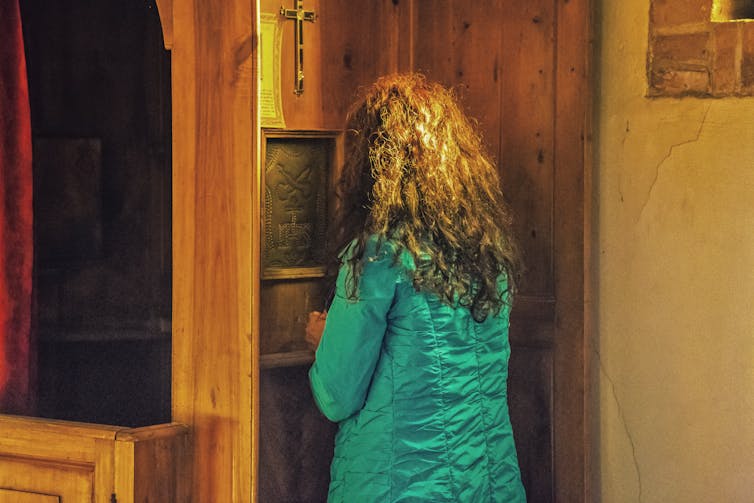Why ending the secrecy of 'confession' is so controversial for the Catholic Church
- Written by Mathew Schmalz, Professor of Religious Studies, College of the Holy Cross
Following sexual abuse scandals in the Catholic Church, there is a worldwide push to end the guarantee of secrecy of confession – called “the seal of the confessional[1].”
On Sept. 11, 2019, two Australian states, Victoria and Tasmania, passed bills[2] requiring priests to report any child abuse revealed in the confessional.
Australia has been at the center of the Catholic Church’s sexual abuse crisis. In December 2018, influential Australian Cardinal George Pell[3] was convicted[4] of sexually abusing an altar boy.
Australian bishops have, however, made it clear[5] that the seal of confession is “sacred[6],” regardless of the sin confessed. With regard to Tasmania’s new law, Archbishop Julian Porteous[7] argued that removing confession’s protection of confidentiality would stop pedophiles from coming forward. That would prevent priests from encouraging them to surrender to authorities[8].
In the U.S., a California bill proposing ending priestly confidentiality regarding the abuse of minors was withdrawn in July 2019 after a campaign[9] by Catholics and other religious freedom advocates.
Catholic confession has been formally safeguarded by the U.S. Supreme Court[10] since 1818. But therapists, doctors and a few other professionals are required to break confidentiality when there is an immediate threat of harm[11]. Priests are not.
Why is confession so important in the Catholic Church?
The act of confession
 The guarantee of confidentiality of a confession in the Catholic Church cannot be easily broken.
GoneWithTheWind/Shutterstock[12]
The guarantee of confidentiality of a confession in the Catholic Church cannot be easily broken.
GoneWithTheWind/Shutterstock[12]
Catholics believe Jesus gave his disciples the power to forgive sins.
In John 20: 23[13], Jesus says to his apostles, “If you forgive anyone’s sins, their sins are forgiven; if you do not forgive them, they are not forgiven.”
This belief extends to priests in “the rite of penance and reconciliation[14].”
This ritual usually occurs in a “reconciliation room[15].” It is in this private place that the priest, in his role as “confessor,” meets face to face with the “penitents” who will confess their sins.
After making the sign of the cross[16] and welcoming the penitent, the priest reads a passage from the Bible that speaks of God’s mercy. The penitent then says, “Bless me Father for I have sinned” and recounts – out loud – the specific sins committed.
Afterwards, the priest may ask questions to make sure that the confession is thorough. He then gives “absolution” – a “release” from the guilt of sin.
Absolution is not automatic. The penitent must perform “an act of contrition[17],” in which they say that they are “contrite” or sorry for their sins. The penitent also promises to do their best not to sin again.
Before dismissing the penitent, the priest gives a “penance” – usually in the form of prayers – that the penitent needs to perform to “reconcile” with God.
History of penance and confession
The present rite of penance and reconciliation dates from 1974[18]. This was almost a decade after a worldwide gathering of bishops at the Second Vatican Council[19] that reformed many traditional Catholic practices.
In the centuries before the change, penance and confession were much more demanding.
In early Christianity, those who committed serious sins – like murder – publicly entered the “order of penitents.” These penitents underwent years of public prayer and fasting before rejoining the community.
Because it was so difficult to repeat the process for serious sins if committed again, many Christians waited until old age to perform penance and be assured their place in heaven[20].
 In early Christianity those who committed serious sins entered the ‘order of penitents.’
Lawrence OP, CC BY-NC-ND[21][22]
In early Christianity those who committed serious sins entered the ‘order of penitents.’
Lawrence OP, CC BY-NC-ND[21][22]
Later, around the seventh century A.D., confession became private[23]. “Penitential manuals[24]” were developed that listed penalties, or “tariffs,” to match the severity of the sin.
Some of the penances were severe, such as making a barefoot pilgrimage[25] to a distant holy place or walking to church on one’s knees. From the 11th century onward, going on Crusade to the Middle East – the Holy Land – was also considered a penance[26] that could erase a person’s sins.
Some of the penances given in the manuals were so strict that local bishops often lessened[27] the penalties. Sinners also had the option to pay someone else[28] to do their penance.
For these reasons, penance gradually emphasized the basic act of confession itself, and prayers took the place of harsher penalties.
The importance of confession
Today, confession is still associated with the older process of going to a confession box and listing one’s sins anonymously from behind a screen.
That was my first experience of penance in the 1970s as a seven-year-old Catholic boy. I was also taught that I could not receive the bread and wine of communion[29] without confessing my sins. This teaching still remains in force.
In recent years[30], though, confession has declined[31]. Fewer American Catholics are going to confess their sins. Some commentators have even argued that confession has “collapsed[32]” and should be rethought.
But regardless of how frequently Catholics go to confession, the freedom to confess – in confidence – is central to the Catholic worldview. And all Catholics of my generation have a confession story – a story that can be either comforting or traumatic.
The debate over confession isn’t just an abstract issue for Catholics. It’s something very personal.
But for me, as well as for many Catholics, confession is not simply a way of avoiding hell[33] in the hereafter – it’s a way experiencing God’s merciful love[34] in the here and now.
[ Deep knowledge, daily. Sign up for The Conversation’s newsletter[35]. ]
References
- ^ the seal of the confessional (www.catholiceducation.org)
- ^ bills (www.theage.com.au)
- ^ Cardinal George Pell (www.theguardian.com)
- ^ convicted (theconversation.com)
- ^ clear (www.theage.com.au)
- ^ sacred (www.ncronline.org)
- ^ Archbishop Julian Porteous (hobart.catholic.org.au)
- ^ priests from encouraging them to surrender to authorities (www.abc.net.au)
- ^ campaign (www.americamagazine.org)
- ^ formally safeguarded by the U.S. Supreme Court (www.mtsu.edu)
- ^ immediate threat of harm (www.apa.org)
- ^ GoneWithTheWind/Shutterstock (www.shutterstock.com)
- ^ John 20: 23 (biblehub.com)
- ^ the rite of penance and reconciliation (www.usccb.org)
- ^ reconciliation room (www.liturgybrisbane.net.au)
- ^ the sign of the cross (www.loyolapress.com)
- ^ an act of contrition (www.catholic.org)
- ^ 1974 (www.nytimes.com)
- ^ Second Vatican Council (theconversation.com)
- ^ heaven (theconversation.com)
- ^ Lawrence OP (www.flickr.com)
- ^ CC BY-NC-ND (creativecommons.org)
- ^ confession became private (www.tandfonline.com)
- ^ Penitential manuals (www.britannica.com)
- ^ pilgrimage (www.internationalschooltoulouse.net)
- ^ penance (yalebooks.yale.edu)
- ^ often lessened (www.tandfonline.com)
- ^ pay someone else (books.google.com)
- ^ communion (www.vatican.va)
- ^ recent years (cara.georgetown.edu)
- ^ confession has declined (www.pewforum.org)
- ^ collapsed (www.bostonglobe.com)
- ^ hell (theconversation.com)
- ^ God’s merciful love (theconversation.com)
- ^ Sign up for The Conversation’s newsletter (theconversation.com)
Authors: Mathew Schmalz, Professor of Religious Studies, College of the Holy Cross

